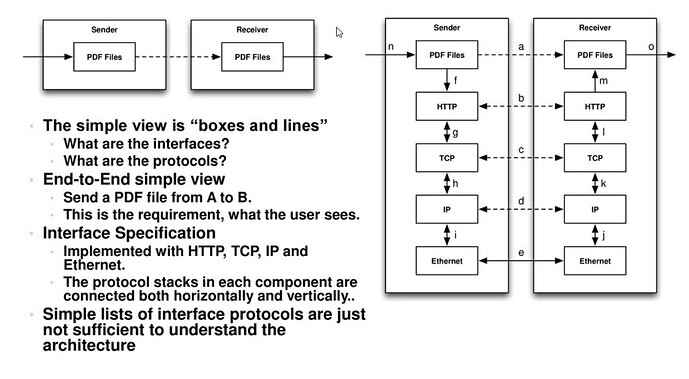Hi,
is it possible to model something similar to that, what is shown in the picture below?
The picture is part of the following presentation (
Modeling Systems-of-Systems Interfaces with SysML - ppt download)
I was thinking about to use the 3 architecture levels (System, Logical, Physical) to model this, but this seems not to be the right solution.
When we have the functions “send PDF file” and “receive PDF file”, than the exchange item is PDF.
When we add a function like “pack into TCP frame” than this is not a refinement of “send PDF file” because this will change the interface. We dive down to a different view level.
Has anybody an idea or an example how to work on this?
Regards,
Andreas
Hi Andreas,
Can we say that all levels a to d are just model, but the detailed reality is e (or lower may be, until we see the electrical connection)?
When I’m a high level user, I model the pdf transfer and hide all the rest in the ports. If I need to go deeper and organize at lower level, then part of the chain each side is pulled out of the ports and appears as translation or transduction function. The EI pdf is still used to go to the translation chain, then you have a new one for HTTP and so on (each level you need to make appear). I see it as similar to a acquisition chain: If you just need to mention you collect a temperature, then the system collect the physical temperature, but if you want to make appear the chain, then you have transduction temperature to voltage, then voltage to numerical, and then use in computing.
Hope it helps
Regards
Thierry
Hi Thierry,
thanks for the reply. What I miss is that it is not possible to show that ‘a’ is send via ‘b’ and so on. So that I can add mapping information. It possible to define that ‘a’ is send via ‘e’ in Capella but not for the other levels. The actual problem what I have is, that I have several signals on application level and I what to show in which message this signals are transfered. For this use case I have not found a solution so far.
Regards,
Andreas
May be there is another option: The xDFB and xAB, scenario use EI describing the functional aspect.
Then you use the EIE to set the lower level description, or one for each level or the first one is typed by a class which contains lower details in its properties, then properties are again typed by a new class…
The point is that with this method, it will not be easy to use values across all these layers if you need to for your scenarios… It would mean using referenced value, the point is they don’t appear as property… May be you would have only the functional one showing values, all the other would have to show signals.
The first one with one EIE by layer, if you have to use value, then you get a kind of value correspondence, set by the EI content.
Regards
Thierry
PS: How I use values as scenario event: EI - Value/Value set> EIE “Signal=Value”>Type=signal
Or an operand with a constraint saying EI-signal/ EIE signal >=< type litteral.
